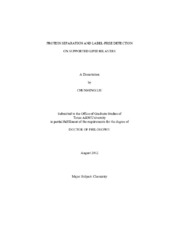| dc.contributor.advisor | Cremer, Paul S. | |
| dc.creator | Liu, Chunming | |
| dc.date.accessioned | 2012-10-19T15:30:49Z | |
| dc.date.accessioned | 2012-10-22T18:03:07Z | |
| dc.date.available | 2014-11-03T19:49:14Z | |
| dc.date.created | 2012-08 | |
| dc.date.issued | 2012-10-19 | |
| dc.date.submitted | August 2012 | |
| dc.identifier.uri | https://hdl.handle.net/1969.1/ETD-TAMU-2012-08-11754 | |
| dc.description.abstract | Membrane-bound proteins and charged lipids are separated based on their charge-to-size ratio by electrophoretic-electroosmotic focusing (EEF) method on supported lipid bilayers (SLBs). EEF uses opposing electrophoretic and electroosmotic forces to focus and separate proteins and lipids into narrow bands from an initially homogeneous mixture. Membrane-associated species were focused into specific positions within the SLB in a highly repeatable fashion. The steady-state focusing positions of the proteins could be predicted and controlled by tuning experimental conditions, such as buffer pH, ionic strength, electric field and temperature. Careful tuning of the variables should enable one to separate mixtures of membrane proteins with only subtle differences. The EEF technique was found to be an effective way to separate protein mixtures with low initial concentrations and it overcame diffusive peak broadening problem. A "SLB differentiation" post-separation SLB treatment method was also developed by using magnetic particles to rapidly slice the whole SLB into many small patches after electrophoretic separation, while keeping the majority of materials on surface and avoiding the use of chemical reactions.
Label-free detection techniques were also developed based on EEF on SLBs. First, a new separation based label-free detection method was developed based on the change of focusing position of fluorescently labeled ligands. This technique is capable of simultaneous detecting multiple protein competitive binding on the same ligand on SLBs. Low concentration protein can be detected in the presence of interfering proteins and high concentration of BSA. The fluorescent ligands were moved to different focusing positions in a charged SLB patch by different binding proteins. Both free ligand and protein bound ligand concentrations were obtained. Therefore, both protein identity and quantity information were obtained simultaneously. Second, the focusing position of fluorescent biomarkers on SLB was used to monitor the phospholipase D catalyzed hydrolysis of phosphatidylcholine (PC) to form phosphatidic acid (PA), which is involved with the change of charge on the phospholipids. The focusing position of fluorescent membrane-bound biomarker in the EEF experiment is directly determined by the negative charge density on SLB. Other enzyme reactions involved with the change of phospholipids charge can be monitored in a label-free fashion in a similar way. | en |
| dc.format.mimetype | application/pdf | |
| dc.language.iso | en_US | |
| dc.subject | Supported Lipid Bilayer | en |
| dc.subject | Electrophoretic-Electroosmotic Focusing | en |
| dc.subject | Protein Separation | en |
| dc.subject | Label-Free Detection | en |
| dc.title | Protein Separation and Label-Free Detection on Supported Lipid Bilayers | en |
| dc.type | Thesis | en |
| thesis.degree.department | Chemistry | en |
| thesis.degree.discipline | Chemistry | en |
| thesis.degree.grantor | Texas A&M University | en |
| thesis.degree.name | Doctor of Philosophy | en |
| thesis.degree.level | Doctoral | en |
| dc.contributor.committeeMember | Batteas, James D. | |
| dc.contributor.committeeMember | Hilty, Christian | |
| dc.contributor.committeeMember | Musser, Siegfried M. | |
| dc.type.genre | thesis | en |
| dc.type.material | text | en |
| local.embargo.terms | 2014-10-22 | |


